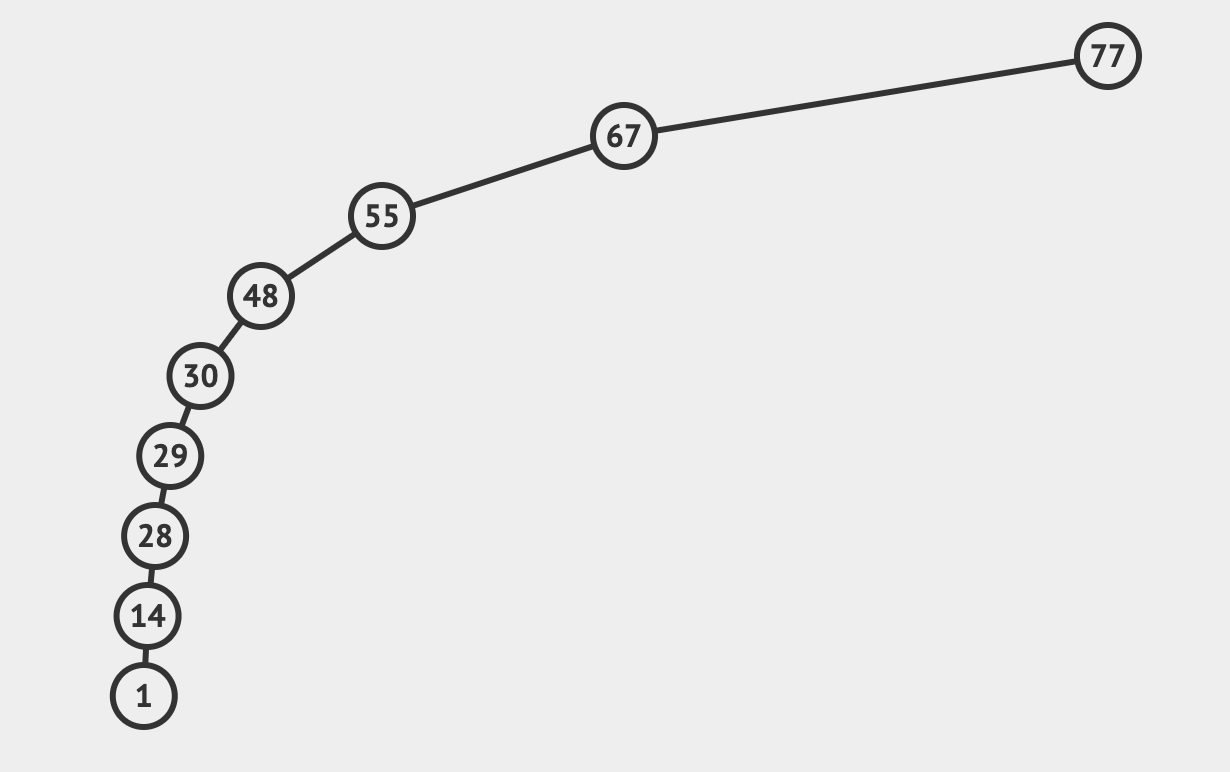Binary Heap
Binary Heap 和 Binary Search Tree 很類似,但規則上有些不同。
有兩種 Binary Heap :
- Max Binary Heap - 父節點永遠比子節點大
- Min Binary Heap - 子節點永遠比父節點大
像上圖就是屬於 Max Binary Heap
而 Max Binary Heap 的規則就只管父節點比子節點大而已,就算某個子節點比父節點的相鄰節點大也沒關係。
還有另個與 Binary Search Tree 不同的規則是,加新節點時,一律往左邊先加,左邊有了加右邊,同層都滿了就到下一層的最左邊開始加。
Binary Heap 可用來實作 Priority Queues,也會在之後會寫到的 Graph Traversal 用到。
推薦觀看此網站的動畫演示
Storing Heap
而也因為必須先加左再加右,同層滿了才可以往下加的規則,所以我們可以為每個節點標記 Index 順序,而存成陣列的形式。
延續上張圖的 Binary Heap
這邊可以觀察出一些規則:
- Index 為 N 的節點,其左右子節點會位於 2N + 1 與 2N + 2 的位置。
- 反之, Index 為 N 的節點,其父節點會位於 (N-1) / 2 取整數 (floor) 的位置
Implementation
由於上述的規則,我們可以將節點們存成陣列形式即可。
class MaxBinaryHeap {
constructor() {
this.values = []
}
}
Insert
新增節點時,我們會將其加在最後面。
沿用上圖例子來說,新增一個 95 :
- 加在最後面 -
[93, 89, 80, 81, 88, 63, 21, 75, 11, 13, 50, 95] - 然後我們需要找到
95的父節點來比大小,這邊可以用上面有提到的 (N-1) / 2 取整數 (floor) 方法來找到 95比其父節點63大,故兩個需要交換位置
- 交換後,
95比新父節點80大,故兩個需要交換位置 - 交換後,
95比新父節點93大,故兩個需要交換位置 - 交換後,已經在根節點的位置 (0) 了,所以結束。

若是比父節點小,就可以直接結束。
insert(element) {
this.values.push(element)
this.bubbleUp()
return this.values
}
bubbleUp() {
let currentIndex = this.values.length - 1
const newElement = this.values[currentIndex]
while (currentIndex > 0) {
let parentIndex = Math.floor((currentIndex - 1) / 2)
let parentElement = this.values[parentIndex]
if (newElement <= parentElement) break
this.values[parentIndex] = newElement
this.values[currentIndex] = parentElement
currentIndex = parentIndex
}
}
ExtractMax
接著來實作移除根節點 (最大值) 的方法。
步驟如下:
- 將最後一個節點與根節點交換位置
- 將最後一個節點移除

- 將新的根節點與其左右子節點比對
- 若比左右子節點小則與其交換位置 (若同時比左右都小,則挑左右之中最大的節點交換位置)
- 直到比左右子節點都大或是已經沒有左右子節點為止

若移除根節點後就沒有其他節點了,就直接回傳被移除的節點,不用再做比對交換。
extractMax() {
const maxElement = this.values[0]
const lastElement = this.values.pop()
if (this.values.length > 0) {
this.values[0] = lastElement
this.sinkDown()
}
return maxElement
}
sinkDown() {
let currentIndex = 0
const element = this.values[currentIndex]
let leftIndex = 2 * currentIndex + 1
let rightIndex = 2 * currentIndex + 2
while (leftIndex < this.values.length || rightIndex < this.values.length) {
let leftElement = this.values[leftIndex]
let rightElement = this.values[rightIndex]
let swapLeft = false
let swapRight = false
if (leftElement && element < leftElement) swapLeft = true
if (rightElement && element < rightElement) swapRight = true
if (swapLeft && swapRight) {
if (leftElement > rightElement) {
swapRight = false
} else {
swapLeft = false
}
}
if (swapLeft) {
this.values[leftIndex] = element
this.values[currentIndex] = leftElement
currentIndex = leftIndex
} else if (swapRight) {
this.values[rightIndex] = element
this.values[currentIndex] = rightElement
currentIndex = rightIndex
} else {
break
}
leftIndex = 2 * currentIndex + 1
rightIndex = 2 * currentIndex + 2
}
}
Big O Complexity
| Search | Insertion | Removal |
|---|---|---|
| O(n) | O(log n) | O(log n) |
沿用此張圖示例
搜尋的部分, Binary Heap 只保證上下節點的大小規則,所以假設要找 13 ,從根節點開始遍歷在第二層遇到 89、93 時這兩個值是都有可能在 13 上面的,所以還是需要遍歷整個節點們。
Insertion 與 Removal 都是類似的,從最後開始往上比對跟從頭開始往下比對,每次比對都是走另半邊,不用全部都比對一次。
至於為何沒有 Worst Case 與 Best Case 呢? 是因為 Binary Heap 一定都是同層加滿後才會往下一層加,不會像下圖 Binary Search Tree 這樣集中分佈在某一邊。

